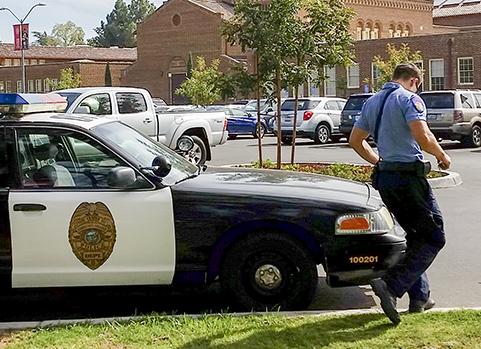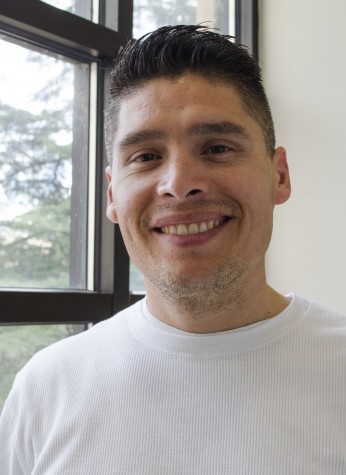Could It Happen Here?

Photo by: George Garnica
Rampage archive photo
Is FCC Prepared to Handle an Active Shooter Situation?
A male freshman was arrested by California State University, Fresno campus police and charged with making a terrorist threat, in connection with a posting he made on social media on Nov. 2.
According to a post on the college website and various news organizations, Christian Pryor, 18, a football player, was arrested on campus and interviewed within two hours after police learned of a Yik Yak posting threatening use of a weapon on campus.
Shirley Armbruster, associate vice president of university communications posted a message on the college website to reassure students about their safety.
“Fresno State is taking the social media threat received Nov. 2 very seriously,” Armbruster said. “We have taken the most stringent action we can in this situation, which includes keeping the individual suspected of posting the threat off of campus, pursuing disciplinary action and removing him from the football team.”
Also on Tuesday, Fresno State President Joseph I. Castro addressed the terrorist threat made on Monday.
“As campus safety is our prime concern, the police team, members of the Cabinet and I closely monitored the situation and worked together to make decisions throughout the afternoon,” Castro stated. “Our team had a plan ready to support a campus closure. As soon as we were alerted that the suspect was in custody and assured that he acted alone, we notified the campus that classes would continue.”
Castro also added that police presence on campus has been increased “to reassure the university community.” Criminal action is pending against the accused.
The Fresno State scare brings the issue that’s becoming commonplace very close to FCC.
Just five weeks ago, a shooting at the Umpqua Community College left 10 dead and seven injured in the southern Oregon town of Roseburg.
In its wake, Fresno City College students are expressing concern about their safety on campus.
In a survey of 165 students on FCC campus, conducted between Oct. 12 to Oct. 30, students identified safety precautions they would like implemented. 45 percent of responders say they would like to see more police presence on campus; 41 percent said they would like weekly safety bulletins while others chose more interaction between students and campus police as well as more safety forums.
Seventy five percent of the respondents were between the ages of 18 and 24.
Almost 60 percent are female, and approximately 83 percent attend school during the daytime. Two-thirds are enrolled full time.
Thirty five percent said they feel safe on campus all the time while 33 percent said they felt safe some of the time. The remainder of the students, 29 or 18 percent, said they did not.
Many on the FCC campus have expressed concerns about the campus’ readiness to handle an emergency such as the one that happened at UCC. What plans, if any, does the college have in the case of an active shooter on campus?
Bruce Hartman, who stepped down as the State Center Community College District chief of police on Oct. 14, said during an interview with KSEE24 News in Fresno, California on Oct. 2 that there are armed officers on campus who are ready for any situation.
“The training here is as in any other location for an active shooter,” Hartman said. “The type of weapons the officers carry are standard as any other agency, and we run drills monthly that test the different systems that would go with it.”
Hartman also referred this reporter to a “Run. Hide. Fight” video released by Homeland Security two years ago to show what to do in an active shooter situation.
The “Run. Hide. Fight.” video demonstrates an armed suspect going into a building filled with employees and starts shooting at random people who come in his path. It then instructs viewers on what steps to take to be safe.
RUN. When an active shooter is in your vicinity:
If there is an escape path, attempt to evacuate.
Evacuate whether others agree to or not.
Leave your belongings behind.
Help others escape if possible.
Prevent others from entering the area.
Call 9-1-1 when you are safe.
If students and faculty can’t get out safely, you need to find a place to hide.
HIDE. If an evacuation is not possible, find a place to hide.
Lock and/or blockade the door.
Silence your cell phone.
Hide behind large objects.
Remain very quiet.
FIGHT. As a last resort, and only if your life is in danger:
Attempt to incapacitate the shooter.
Act with physical aggression.
Improvise weapons.
Commit to your actions.
The “Run.Hide.Fight.” tips were also given to professors in a training last month according to Wendell Stephenson, president of the FCC academic senate who represents campus professors.
“We had other trainings in the past where we talked about other issues such as earthquakes, bomb threats — that sort of issues, but most recently it was about active shooters because of obvious reasons,” Stephenson said.
“There’s been shootings, some most recently as it is well known up in Oregon at their community college which comes very close to our home,” Stephenson said. “That’s why the most recent concern of active shooters here.”
FCC also has other safety plans in case of an emergency situation in the college offices.
According to Interim President Cynthia Azari, almost all the offices have a phone that has a button that has the police department on it, and it dials directly to them.
“If someone is belligerent, or if there is a problem, or if somebody is concerned, I just push that button and they come,” Azari said. “It is an office phone, and we want to be able to get the police to come as soon as possible.”
Azari also said the college will conduct a training in the near future that would help the college be ready.
“I have talked to a district vice chancellor over at the police department, and we agree that we need some active shooter training, so we are going to try to schedule that,” Azari said. “Sometimes, it takes a little bit longer to schedule things, but we will do that.”
FCC students Allie Cisa and Devyn Castro said they do not feel safe on campus, and they rarely see police around campus.
“As a girl, you see people walking around that you can tell are not students here, and there are guys that are approaching you all the time, and that is really uncomfortable,” Cisa said. “There is no one around to see that you are trying to get away.”
Castro stressed another concern that might be a problem in an emergency situation on campus.
“I like that they have text alerts, but I have not received one this semester, and I know there has been stuff going on,” Castro said. “There needs to be a test text alert sent out, so we know it is working.”
The text alert that Castro is referring to is a program called 1st2know which is an SCCCD emergency alert messaging system. Students and staff can sign up through their webadvisor account.
Those registered for the 1st2know alert system receive a text message notifying them when there is an emergency on campus. But in a survey conducted by the Rampage, several students like
Castro, said they had not received any text messages at any time this semester.
This alert system is also being promoted by Austin Bailey, campus safety senator for the Associated Student Government [ASG], who said it is the first tip he wants to give students.
Bailey also said that he believes that overall, FCC is a safe campus. He wants students to walk into the ASG office and discuss whatever safety concerns they have.
“This campus is wide open as most community campuses are,” Stephenson said. “There is no fence around, no security checkpoints, so we have to come to the realization that anybody can walk in here and are vulnerable if someone should take that into their head, so we have to hope they don’t, and that we are ready just in case.”

George Garnica is going on his second year at the Rampage and has now taken the position as Multimedia Editor. He is currently working on his Journalism...

